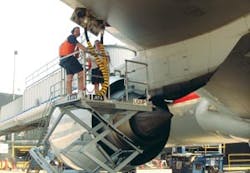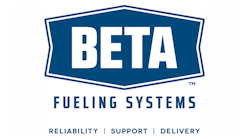As an established global supplier of aircraft refueling equipment, tanker equipment and terminal loading systems abroad, Liquip International looked to the North American aviation industry as a major growth opportunity. With its recent acquisition in North America of Beta Fluid Systems, the company has maneuvered itself into the military sector and is vying for a stake in commercial aviation with an offering of its global insight.
A land of GSE opportunity
Formed in 1968, the Australia-based company has specialized in tanker equipment for fuels and associated chemicals. It then formed its aviation division in the mid-80s, servicing major oil companies in Australia, Asia and the Middle East.
Viewing the North American region as a market of special potential, Liquip has made a concentrated effort to expand its presence. “The North American market is a key strategic one for most companies in our line of business, from both a scope and scale perspective ... it gives us the economies of scale we need to ensure we remain competitive on a global scale, and exposes us to a diverse range of operational needs, enabling us to continue broadening our product offering,” says Jeff Borg, president of US operations at Liquip International, based out of North Carolina.
In 2006, Liquip acquired Beta Fluid Systems, a manufacturer of refueling equipment for the military. The acquisition laid the groundwork for the company’s ambitions in the North American market, offering an opportunity for manufacturing within the US. “The core competencies that this acquisition brought us within the defense sector, and the ability to leverage our global experience in the US commercial sector made this a very important and successful acquisition,” Borg says.
“Beta is a well established business, with an excellent reputation in the military field,” Borg says, “and an excellent platform for growth into the commercial aviation sector. The synergies between Liquip and Beta were perfect.” The company now has manufacturing sites in North Carolina, as well as multiple manufacturing sites in Australia.
With its manufacturing operation in the US, Liquip has expanded within the military sector and increased capacity. “Historically our (Beta) focus in USA has been military, so we’re a big military supplier and our operations have been geared accordingly,” says Frank Montalvo, director of sales and marketing for US operations, who recently joined Liquip from the Liquid Controls Group. “Now in addition to that, we’re also serving the major airlines and service providers in the US and we’re really growing our commercial aviation offerings.”
Global practices
Included in its aviation product base are filtration equipment, hydrant carts and aircraft refueling tankers. As a company with a global perspective, Borg says the Liquip product offering is unique to the North American market. “We are introducing positive product enhancements in terms of performance, reliability, ergonomics and safety. Many of the reliability and safety features originate from our global experience in manufacturing refueling equipment for harsh and remote operating conditions in the middle east, Australia and remote pacific islands where equipment survives in harsh conditions and needs to exist with minimal support,” he says.
To continue servicing the defense sector while expanding into commercial refuelling equipment, Borg says the company has increased the level of “automization” within its products. “What we’ve done is attempt to remove the human element as much as possible. From a human factors engineering point of view, we don’t want the operator to need to memorize a certain complicated sequence of operations to be able to operate the vehicle, so we’ve brought a lot of automation to the process of refueling,” he says.
One such product developed by Liquip to reduce manual labor in the refueling process is Diptronic — an electronic, real-time device for fuel-level measurement. Designed for use in mobile refueling tankers, the device records fuel levels 240,000 times per second, offering users a constant, accurate measurement of tank contents.
Borg says the product offers several benefits on the tarmac, including safety and efficiency. “The opportunity with this product is it removes the requirement to the operator to get on top of the tank,” he says. As well, he says, the programmable alert levels can be used to provide primary overfill protection.
The Diptronic system can also promote overall efficiency, Borg says. “Two scenarios commonly play out. Many times the driver prematurely loads fuel to the truck where they may have been able to fuel another aircraft with the existing fuel onboard, resulting in a wasted operation. On another occasion they may run out of fuel during an into-plane uplift potentially causing a flight delay. This situation could have been avoided with Diptronic which would have told the operator that the tank should be filled before the refuelling operation was started,” he says. “In addition to the safety issue which we’re addressing with the one product, we’re also increasing productivity out in the airfield in that the trucks are being used to maximum efficiency.”
Diptronic was recently implemented in military trials of a system which represents a major shift in efficiency. Using Diptronic to control tank levels, a refueler was hooked into the hydrant system on the ground allowing the tanker to be refuelled at the same time as the aircraft. “Those trials have just finished very successfully,” Montalvo says. “This system makes a massive impact on operational costs, reducing the number of men required for the operation, reducing the amount of mileage the trucks do, saving fuel consumption by not driving the trucks back to the fuel farm, reducing wear and tear on the trucks and finally they may not need as many vehicles to carry out the same operations.”
The positive benefits of these trials could have implications for the commercial sector as well. “The benefits of this system are too great for commercial refuelling not to take notice and we see this system rolling out into similar applications for commercial into-plane refueling,” Montalvo says.
Along with increased automation, the company has focused on reducing maintenance for its equipment. The company has switched from air systems to electronic or fuel-over fuel systems, a move it believes could conserve valuable time on the ramp during frigid weather, preventing delays. “One of the big issues for air systems in cold climates is that the moisture within the air freezes,” Borg says. “and this can bring the system to its knees in some airports at times if they have cold snaps. By moving to an electronic management system for the vehicle we completely avoid this scenario.”
Borg says the company, which has experienced extensive growth recently, has anticipated further expansion. “The growth has been predominantly our business within the military sector which has grown three-fold,” he says. “And we expect similar growth through our new focus on the commercial sector both locally in the North American market and abroad.”






